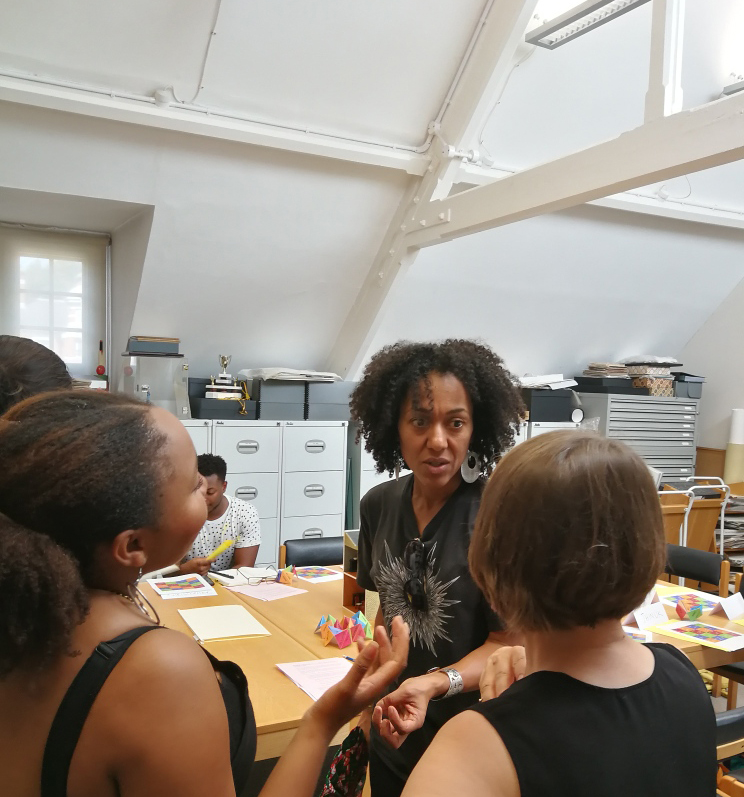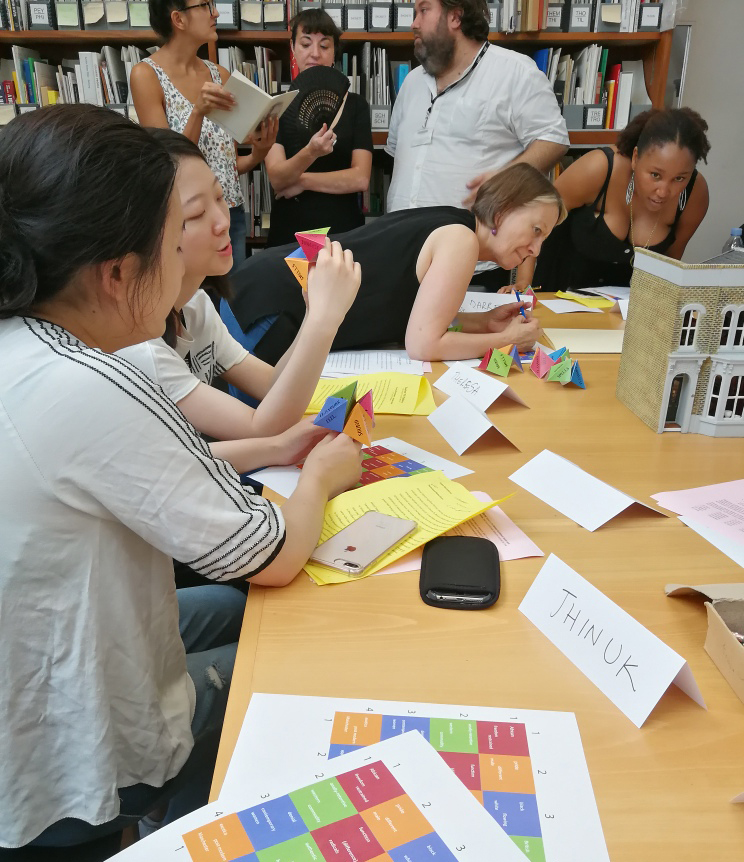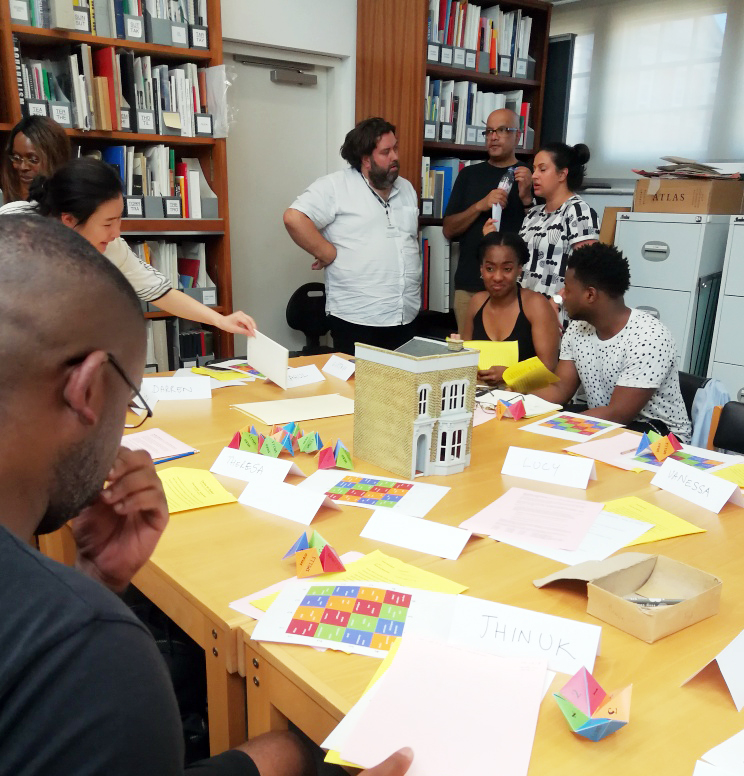Final report by Gustavo Grandal Montero (PhD, CCW), Rahul Patel and Jhinuk Sarkar (PG Cert, Academic Practice in Art and Design)
Funded by the Post-Grad Community Project Fund
On Friday 3rd August a workshop led by Gustavo Grandal Montero (PhD Candidate and Academic Support Librarian), Rahul Patel (CSM/Academic Support Lecturer and MA Academic Practice student) and Jhinuk Sarkar (Academic Support Lecturer and MA Academic Practice student) focused on the connections, similarities and differences between archival documentation and artworks. It explored selected material related to the artist Yinka Shonibare taken from the Ephemera Collection, the Artist Multiples Collection, and the African-Caribbean, Asian & African Art in Britain Archive. All three are part of the Special Collections at Chelsea College of Arts Library
The session aimed to develop:
- a greater understanding of the reasons why these collections were established, providing an opportunity to discover and handle their content;
- awareness of the significance of primary documentation and artworks in the research process;
- Insights into the curation of collections and archives in relation to the representation of potentially marginalised groups and decolonisation.
It was a participatory session, with the first half concentrating on reading and critical discussion, while the second half explored object-based learning and sensory perspectives.
The text Prolonged Seduction was read and discussed at the session. It was Yinka Shonibare’s catalogue introduction for the exhibition of Seen/Unseen which in opened March 1994. Playful and provocative, Shonibare used it to politicise his art.
 Critical discussion centred on the words: Africa, identity, appropriation, colonial construction, indigenous and contemporary post-modern. The group sought context and clarity, and discussions were thoughtful and engaging.
Critical discussion centred on the words: Africa, identity, appropriation, colonial construction, indigenous and contemporary post-modern. The group sought context and clarity, and discussions were thoughtful and engaging.
This allowed us to reflect on the artist’s introduction to his exhibition and also on the themes and contexts of colonialism, post-colonialism and the new internationalism (neo-liberalism and globalisation). The time for this part of the session passed incredibly quickly and we could have carried on for another hour.
The second half of the session explored the object: Shonibare’s Dolls House, an artist’s multiple made in an edition as part of the Norton Family Christmas Project, now part of the Multiples Collection. The Doll’s house, a model of a Victorian house which was based on the Shonibare family home in Hackney, London. The multiple was placed for all to see and examine, in the middle of the table in the Special Collections Room.
We consolidated some of the discussions from the first half of the session with the use of object-based learning from a sensory perspective. Using a playful process of random selection, we used different sensory perceptions to focus and contextualise the meanings and effect of the Doll’s house. Interesting outcomes were discussed.
Timings again restricted conversations but it allowed us to sample how we could have explored the object to the full if we had extended the running time.
 The workshop was open to all UAL students and staff and was aimed in particular to those undertaking the PG Certificate in Academic Practice in Art and Design and the Shades of Noir Teaching Within Project. Numbers were unfortunately limited to 12 participants due to the nature of the session and we were inundated by a large number of people who wanted to attend. We did set up a waiting list. In the end we disappointed a large number of people who could not be accommodated. The participants were from all parts of the University which included design, fashion, fine art, spatial design, contextual studies and performance art students and staff.
The workshop was open to all UAL students and staff and was aimed in particular to those undertaking the PG Certificate in Academic Practice in Art and Design and the Shades of Noir Teaching Within Project. Numbers were unfortunately limited to 12 participants due to the nature of the session and we were inundated by a large number of people who wanted to attend. We did set up a waiting list. In the end we disappointed a large number of people who could not be accommodated. The participants were from all parts of the University which included design, fashion, fine art, spatial design, contextual studies and performance art students and staff.
One of the most interesting aspects of the session were the participants. They were students – both undergraduates and postgraduates and also staff as well (Academic and non-academic). This combination ignited discussions that wouldn’t have necessarily taken place if the tutor and the student framework was part of the set up. Everyone was on equal footing and had something to contribute as well as had something to gain in terms of critical knowledge. It was a successful outcome and feedback was incredibly positive.
We concluded that we should in the future consider further sessions. However, for the future sessions we would separate the first and the second into two separate sessions to allow participants for more in-depth explorations of texts and objects. We would need to secure support and funding for the ASLs.
At UAL we have a huge amount of resources (archives, collections and the knowledge of both academic and non-academic staff and students) which we believe can used in more experimental collaborations, and this session was a success in achieving this.
Finally, thank you to all those who participated and the Postgraduate Community Fund for allowing this to happen.


